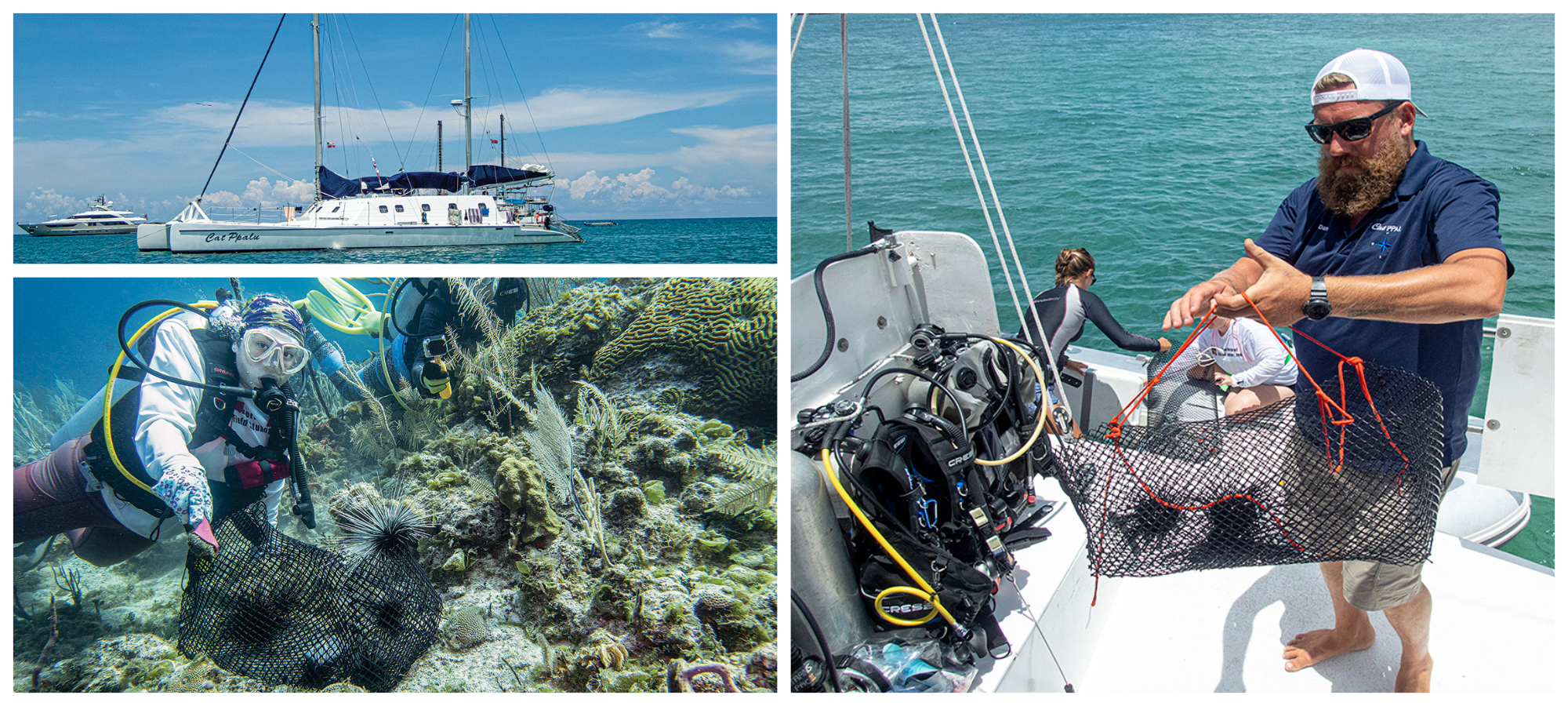Inside the Liveaboard Rescue Mission for Exuma’s Urchins
“Hey, are we gonna get to do that urchin thing?”
That hopeful query is the first thing I hear when I come aboard cozy Cat Ppalu, All Star Liveaboards’ 65-foot catamaran, glistening from a light spritz of rain that’s just passed over its home marina on Nassau’s east side, in full view of the soaring Paradise Island bridge.
The question comes from one of many repeat guests aboard—more than half sailing this week are returning customers. Even though this is my first time, I know what he’s talking about, for this is a cruise with a mission.
We haven’t left the marina and our quest begins. “Wanna come collect urchins?” asks my dive buddy, Addie Benz, 25, All Star’s resident marine biologist and co-leader of this citizen-science liveaboard trip.
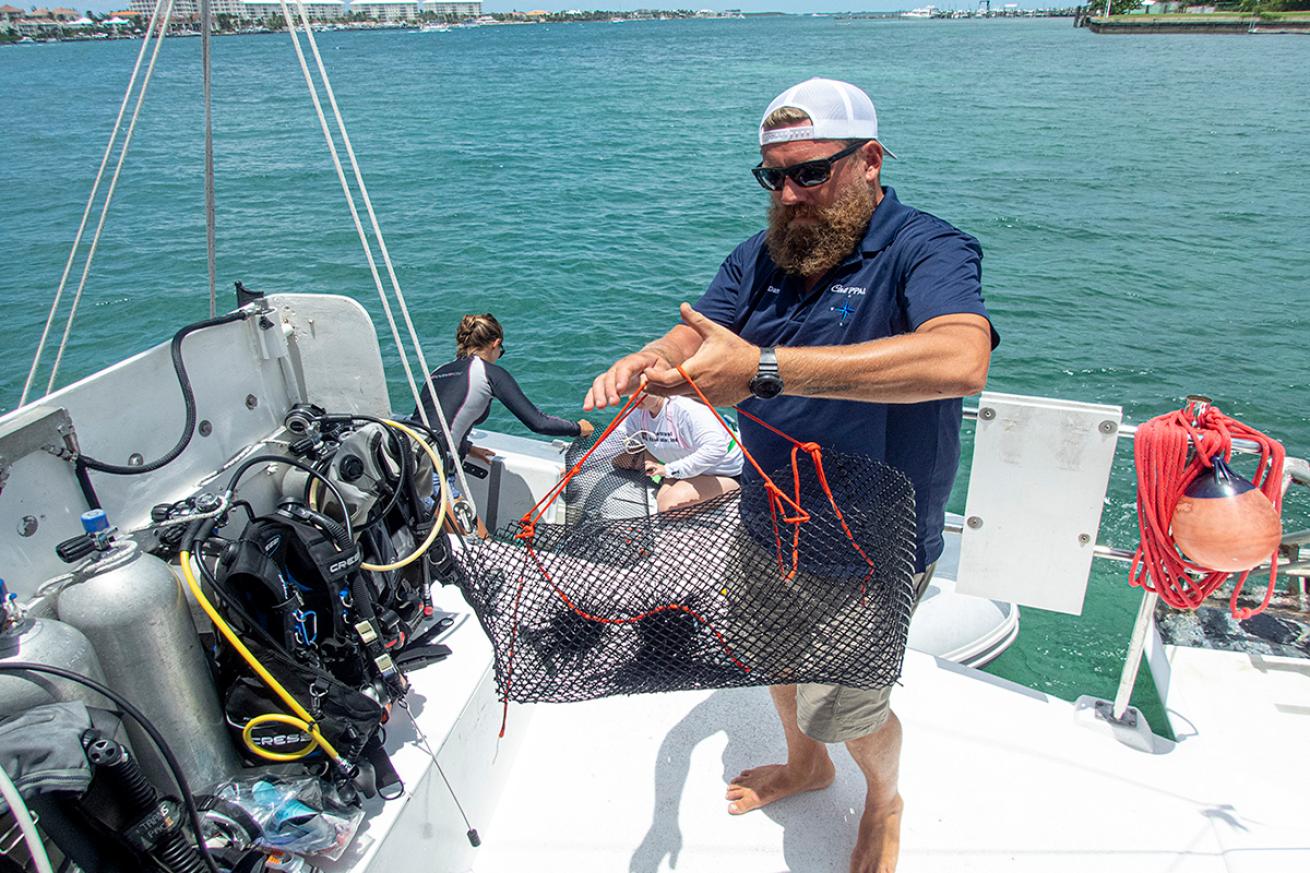
Mary Frances EmmonsCat Pplau engineer Dan Demers helps transfer urchins harvested for transplant from the shallows to deeper reefs.
Grabbing mask, fins, a couple of coolers and some tickle sticks, we hop in a dinghy; dive instructor Martyna Pietkiewicz takes the tiller and we roar around the dock toward Potters Cay. Along the seawalls of Nassau Harbour are so many Diadema antillarum we can see them from the dinghy.
Flopping over the side into a few feet of water, we drop weighted wire baskets and each take a wand, sliding them gently under the urchins and trying to lift them carefully into the baskets. The urchins aren’t so down with this, so there’s a bit of a bobble, like balancing an egg on a spoon. Really it’s more like a Hogwarts class: It takes practice to coax these fantastical creatures to do your bidding, and fantastical they are.
Not much is known about the intelligence or habits of individual Diadema antillarum—they have intriguing ways of resisting study, including scraping off nail polish markings. They can use their spines—which they collapse nearly flat to slip into small spaces, then re-erect and lock in place—in finger-like fashion to remove wire-wrap identification tags. Despite having three eyes on top of their head, they have poor eyesight, perceiving their world as black-and-white shapes. Their sensitive spines help make up for that—each can be consciously controlled. Benz shows me how to coax the spiny balls off the bottom and into the baskets. She motions me to open my hand flat, something I’m reluctant to do, having spent a lot of time underwater trying to avoid urchins. She gently places the creature on my palm, where I’m immediately tickled, literally. Six-inch spines notwithstanding—their mildly venomous spikes can reach up to a foot—there’s something adorable about its tiny, suction-cup tube feet.
Searchin' For an Urchin
“Once there were islands in the Bahamas you couldn’t approach because of so many urchins. The favorite pastime was breaking them open and feeding the fish.” All Star’s founder Bruce Purdy gives me a sideways look. “You’d be ostracized for that now,” he says with a shake of his head.
At 74, Purdy still has the authoritative bearing and demeanor of the pilot he was, in Vietnam and then for Braniff, until he chucked it all in 1982 for the liveaboard life.
At almost the same time, in 1983, a ship came through the Panama Canal and emptied its bilge, spreading a disease common in the Pacific but new to the Caribbean and Atlantic. Scientists began to notice that typically shy long-spine urchins—the most important herbivore in the region—were coming into the open, dropping their spines and dying. The problem quickly spread—in a year there wasn’t a sea urchin in the region, Purdy says. Populations dropped by 95 percent across the urchins’ entire range.
“I didn’t see one for 20 years,” Purdy says. “Everybody thought they were a pain in the butt anyway, and that parrotfish would do their job eating the algae, so what’s the loss?”
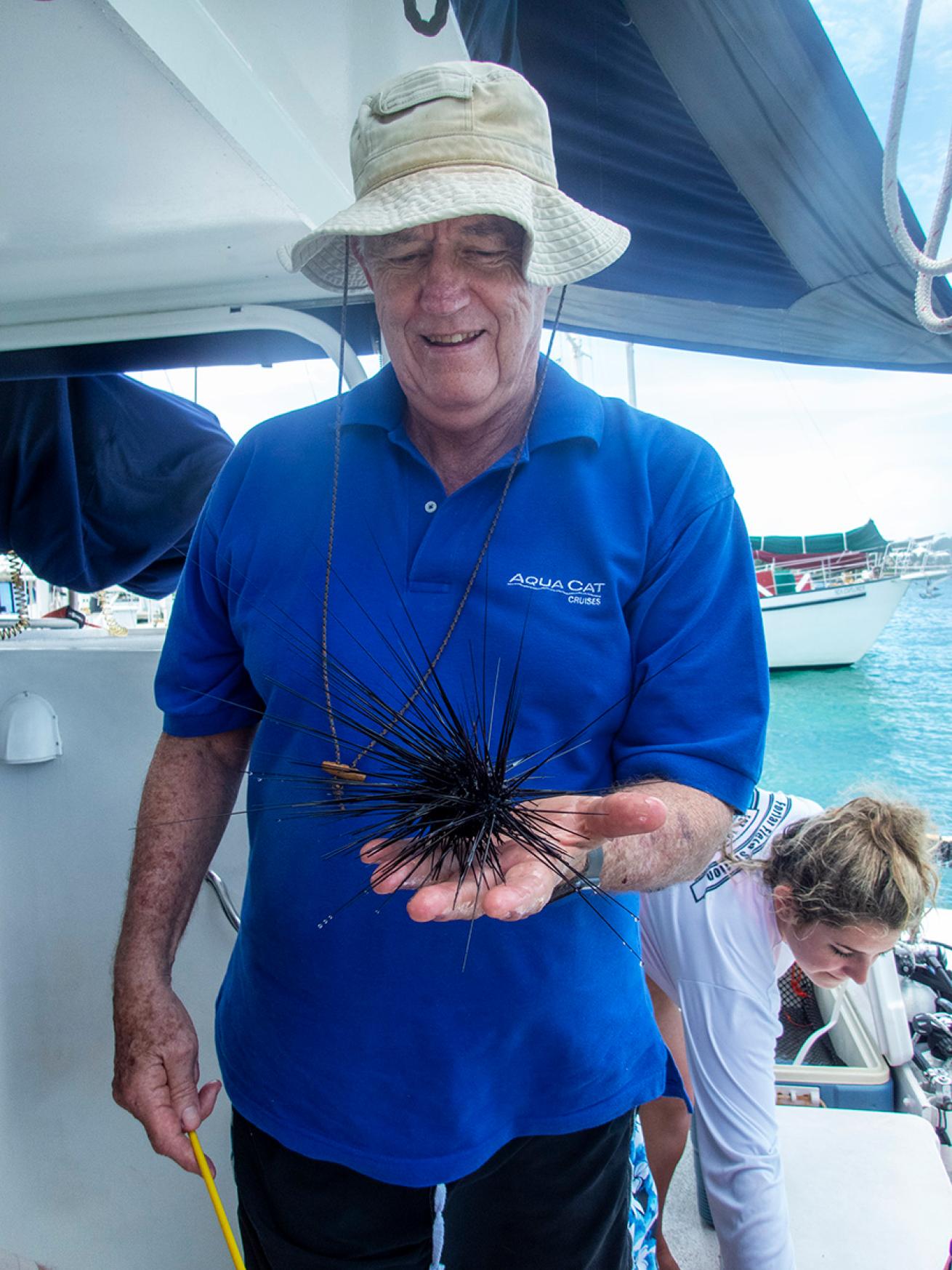
Mary Frances EmmonsAll Star founder Bruce Purdy with Diadema antillarum.
That didn’t happen. Coral coverage had been up to 60 percent in the Caribbean; over the next 17 years it declined to as little as 40 percent. As coral died, algae took over, and new coral could find nowhere to settle. Severe warming episodes in 1999 through 2001 bleached and weakened corals further. Over the next few years, new coral diseases emerged; coverage dropped in some places to 10 to 20 percent or less. Scientists panicked.
Purdy had ordered a new boat from Australia that kept him away from the Exumas for a year and a half. When he returned, he thought, What happened to the reef? He started making calls to the scientific community, trying to get a survey done, but it was difficult to find anyone with both interest and funding.
Over time, Purdy and others noticed urchins making a small comeback in shallow water. Might it be possible to grow them in a lab and transplant? A University of Miami study raised 60 to 70 urchins and transplanted them on an Exumas reef. They lasted a decade, until a hurricane damaged the study area, but it was a slow and laborious process.
Purdy, meanwhile, had moved to the Bahamas and was trying to grow urchins along his Freeport seawall. With the help of some Smithsonian scientists, he figured out that, while certain algae is the urchins’ food source, something associated with the particular algae on his seawall also was toxic to them. Could something like this toxin be suppressing the resurgence of the already weakened urchin population in the wild? Scientists still are not sure.
Citizen science was not a new idea for Purdy or Cat Ppalu. “This boat found the first lionfish in the Bahamas,” Purdy says, in 2003 near Nassau’s Blue Hole. For two years Cat Ppalu ran regular trips to collect study samples.
Suspecting that the absence of urchins was linked to the drop in coral coverage, Purdy and his crews began systematically removing densely overgrown algae by hand, transplanting urchins harvested by permit in shallow water and revisiting those sites to check for evidence of urchin survival—tough to document because the first thing a transplanted urchin does is look for a place to hide. Purdy estimates he’s moved 800 to 1,000 so far, with no way to know how many have survived.
Yet coral, like hope, springs eternal. Around the wreck of the Austin Smith, off the Exumas’ Highbourne Cay, there was a beautiful reef in the late 1990s. Then the coral died. “Now there’s a circle around the wreck where it appears urchins have cleared, so coral can settle on that bare limestone. We should see the coral start to grow back,” Purdy says. He tells me to pay attention underwater—reefs that have urchins have virtually none of the smothering network algae, Microdictyon marinum. “Urchins are like a rototiller,” he says. “Unless you have urchins, you won’t have much luck with coral.” Later in the week we visit the wreck and, sure enough, Purdy points out baby coral sprouting like mad.
Scruba-dub-dub
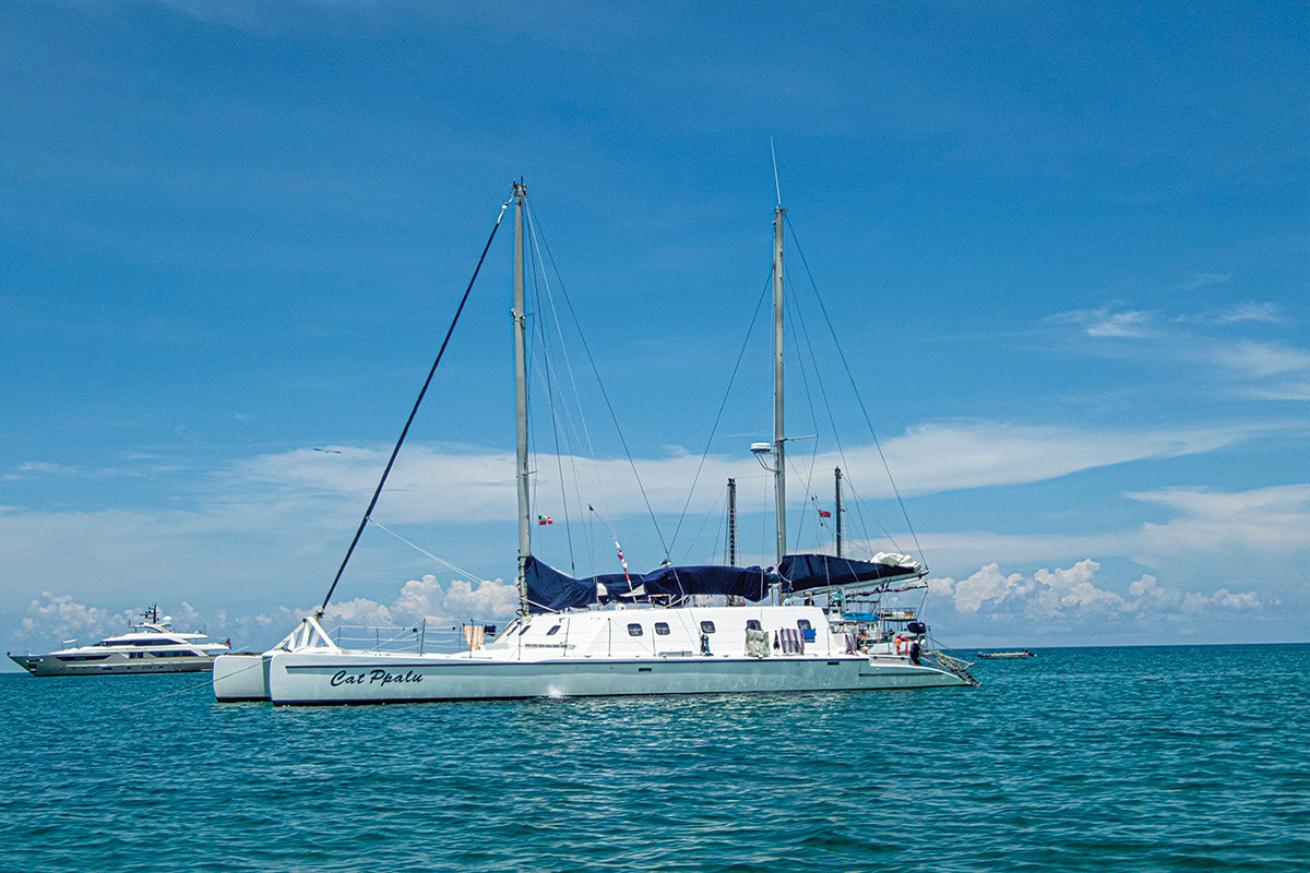
Mary Frances Emmons“This boat found the first lionfish in the Bahamas,” Bruce Purdy says, in 2003 near Nassau’s Blue Hole.
On a bright Sunday morning at Dog Rocks, a spectacular site with cathedral-like swim-throughs at the Exumas’ northern end, Benz tells those who want to help to stow gloves and a brush in our BCs—the brushes float, as most of us comically learn the hard way. We’ll do a dive, and scrub after.
But first there are urchins to bring down. Benz and Purdy carefully remove a dozen from coolers equipped with aquarium bubblers that keep the water fresh in the 24 hours or less from capture to release. Just tilt the baskets and they’ll climb out, Benz says. If any is reluctant, touch the spines on one side with a tickler; it’ll rapidly exit the other way.
Purdy seems equal parts anxious and eager to inspect the area—Cat Ppalu cleared this site a month ago, so we’ll see if network algae has again taken over.
As soon as we descend I can see it’s going to be hard to choose work or play—everywhere you look is loveliness incarnate, from top to bottom. Black coral hangs from the wall in heavy drapes of green and other hues, with tiny, delicate crabs arranged like jewels; down on the sand, curly brittle stars tuck up under the wall. Massive elephant ear and rope sponges overlap one another as far as I can see, and small grouper patrol everywhere.
Back at the top, we set to work scrubbing substrate near the mooring. Wielding a wire brush anywhere near a coral head feels pretty alarming at first. But the coral is a goner if the algae layer remains—and it doesn’t just remain, it proliferates. A couple of damselfish mount a protest, darting in and out with horrified looks; I remember with guilt that some damsels farm algae. (Oops, sorry.)
As we ascend, I turn to look back and I’m surprised—from above, it’s clear that, for now, at this site, divers have made a difference.
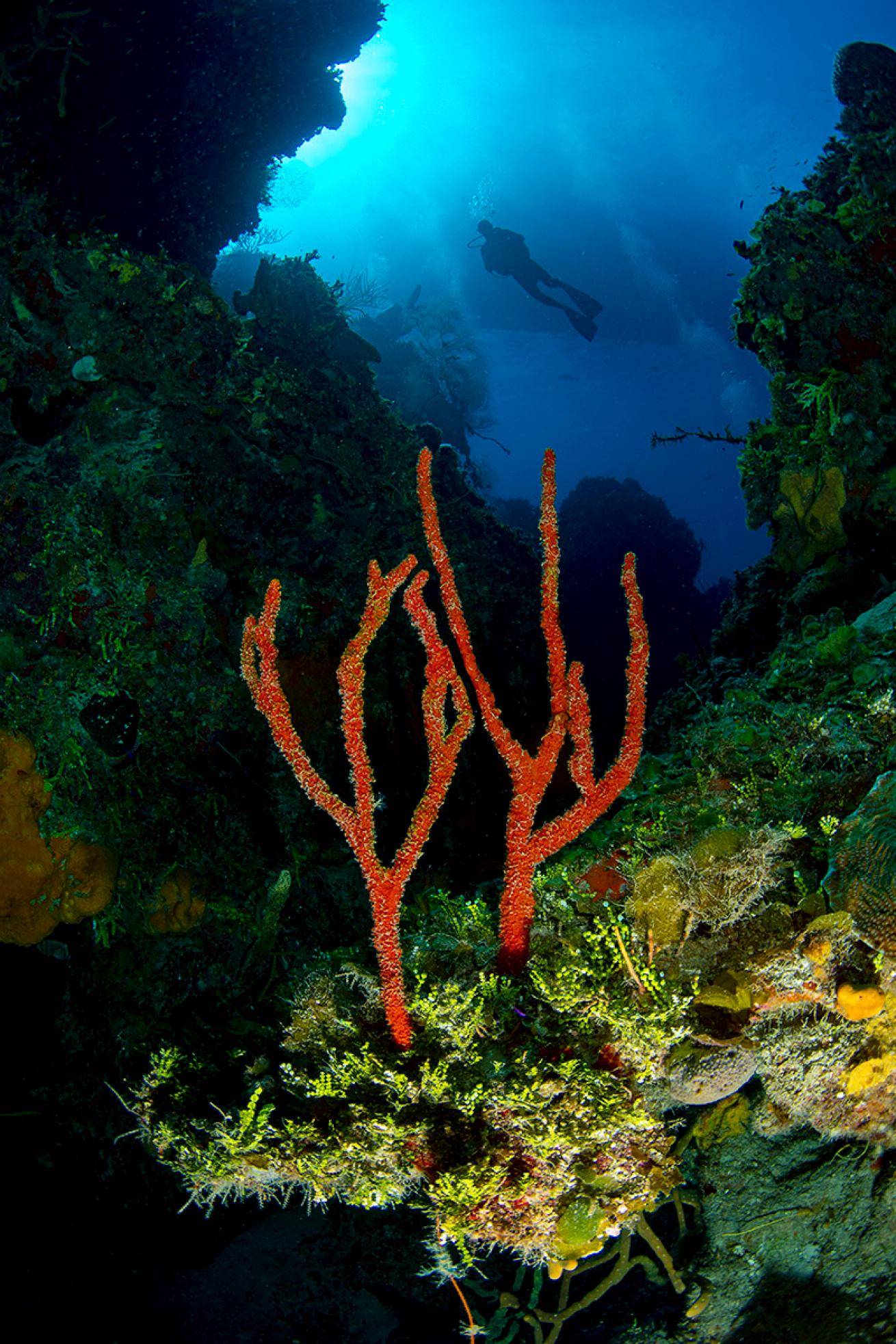
Tanya G. BurnettA red sponge grows on Dog Rocks in the Exumas.
A day or two later we are briefed on a test area at another gorgeous dive site, Blacktip Wall. “Who wants to carry down a basket?” Benz asks. Hands shoot up.
As soon as the baskets are laid on their sides below, the biggest urchins make for freedom at surprising speed, spines waving. They seem happy, for a creature that has no earthly way of showing it. In no time they find perfect urchin-size holes and make themselves at home. Then, under a cloud of network algae I have loosened, I spy a baby urchin the size of a dime, attached to the substrate. The thrill of victory!
Benz takes my slate: “ROCK-BORING URCHIN.” The agony of defeat: wrong urchin. I scrub faster. Purdy sees that reaction over and over. “Every trip, they’re enthusiastic about participating. We’ve had some people come back over and over,” he says, just to help.
Chris Escher, 33, from Daphne, Alabama, is here on his first liveaboard trip. His family picked this Cat Ppalu trip for its citizen-science focus. An ebullient new diver, he’s elated at the whole experience, and coins our unofficial motto: “Searchin’ for an Urchin.” He’s thrilled to get a chance “to make a difference” while still getting in a lot of recreational diving. “Besides seeing my daughters born, this was the best week of my life,” he beams.
Later, Benz takes the long view, putting my fumbling efforts in perspective. “Every person can help a little. In the long run, that helps the big picture. It doesn’t take one person to do everything perfectly—a bunch of people can do this imperfectly,” she says with an encouraging grin.
Of course, the week isn’t all serious. Cat Ppalu’s crew is skilled and professional, but also fun, and funny. Transplanted Canadians, I assume they’re escaping the weather.
“Mostly bears,” our captain, James Miller, says cheerfully. “Haven’t seen one yet!”
Pietkiewicz, a talented macro shooter, has a gift for finding the small stuff. Engineer Dan Demers is the busiest—and most popular—man aboard: This week he’s doubling as chef, and tantalizes us with aromas of beef tenderloin, biscuits and gravy or spaghetti Bolognese wafting from the galley, Cat Ppalu’s warm heart.
Our surroundings also feed the feast for the senses. Each sunrise surpasses the one before, with light, fluffy layers of meringue clouds lying low across a lemony rind of rising sun. Seabirds in numbers dive and cry in the breeze, while nearby dolphins fish and turtles mate. Glorious.
Purely “fun” dives also abound, like our ride through Hammerhead Gulch, a cut on the Great Bahama Bank side of the Exumas. Flying through on a stiff current we’re joined by stingrays, hawksbill turtles, huge nurse sharks and a school of great Atlantic barracuda. Below us, small coral bommies shaped like fondant sculptures in deep purples and shocking orange and yellow dot the icing-white bottom, almost too perfect to be real. Delightful—and no algae anywhere. Later I wonder if the current plays a role. No, Purdy says, Diadema are present, even if we did not see them.
By the end of the week, what stands out most is the perseverance exhibited by Purdy, crew and their guests in the face of daunting odds. “We’re all committed,” Purdy says. Can clearing algae and transplanting urchins by hand succeed in the Exumas? No man can say. But we know what will happen if we do nothing.
Looking around as we work, it’s hard not to be overwhelmed by the enormity of the task. But time and again, I think of the parable of the starfish.
A young boy tossing beached sea stars into the surf encounters an old man who chides him. Surveying the many still on the sand, he tells the boy his small effort cannot possibly matter, weighed against the multitude.
The child pauses, then replies. “It mattered to that one.”
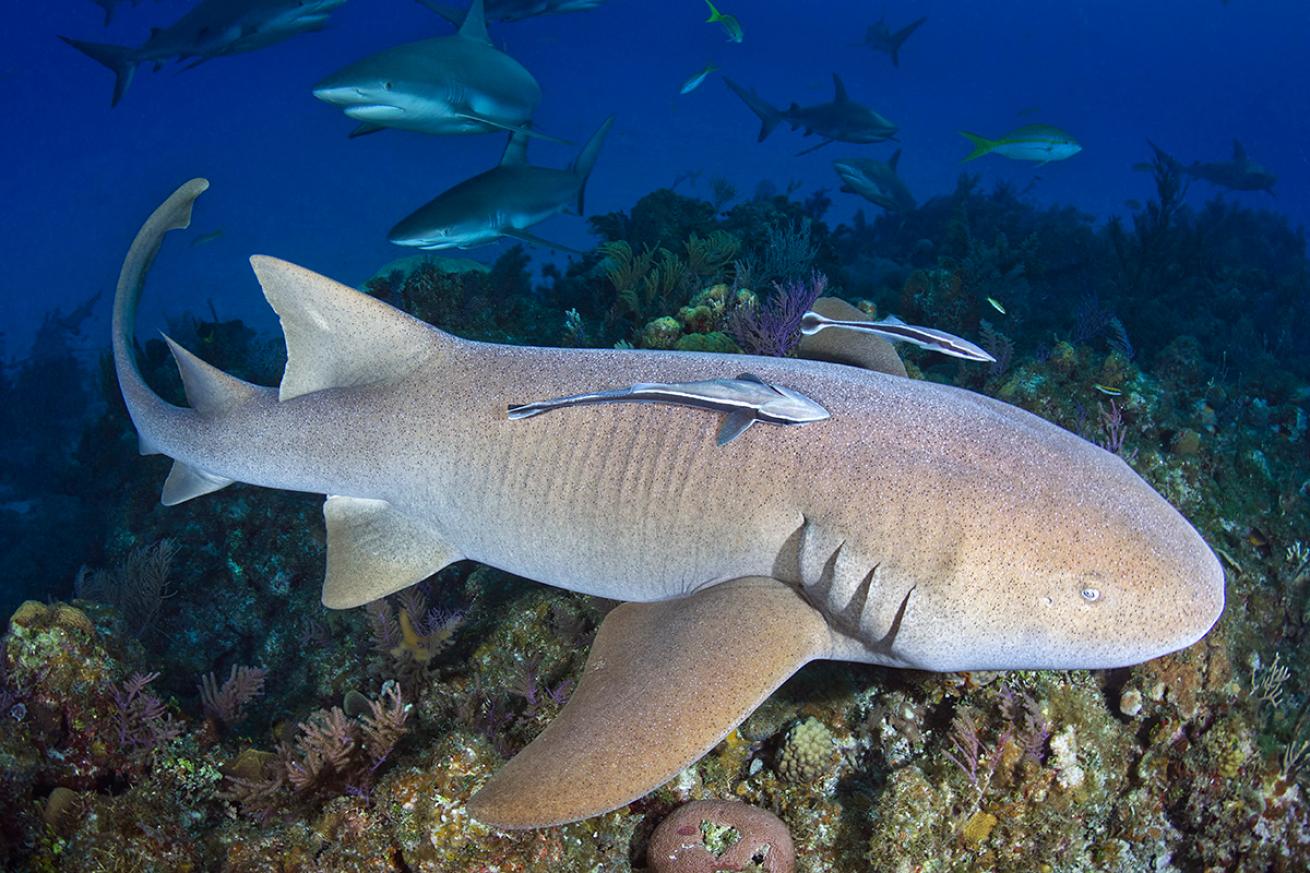
Andy Murch, OceanwideImages.comNurse sharks are huge, fast and plentiful in the Exumas.
NEED TO KNOW
When to Go Cat Ppalu offers year-round itineraries in the Exumas, a central island chain that offers some of the best diving in the Bahamas.
Dive Conditions Water temps in summer and fall are typically in the high 70s to high 80s; many divers skip an exposure suit altogether or opt for a skin or shorty. Water temps in winter are in the low ’70s; a 5 mm fullsuit is recommended for repetitive diving. Some dive sites can be affected by tides and subject to current; that also can affect visibility, which typically ranges from 60 feet to limitless.
Operator Cat Ppalu, operated by All Star Liveaboards (allstarliveaboards.com), offers individual berths but also can be rented as a half (six guests) or whole charter (12 guests). Voyages typically are one week; longer cruises can be arranged.
The 65-foot crewed catamaran sailboat with a 31-foot beam has six air-conditioned cabins, each with sink and mirror, that accommodate 12 divers in four double beds and four twin beds; there are two shared electric heads and showers.
Price Tag Individual rates for 2020 start at $1,695 per person, plus $145 in port fees; full boat charters for 2020 are $16,950, plus $1,740 in port fees.
Get More Conservation Diving:

